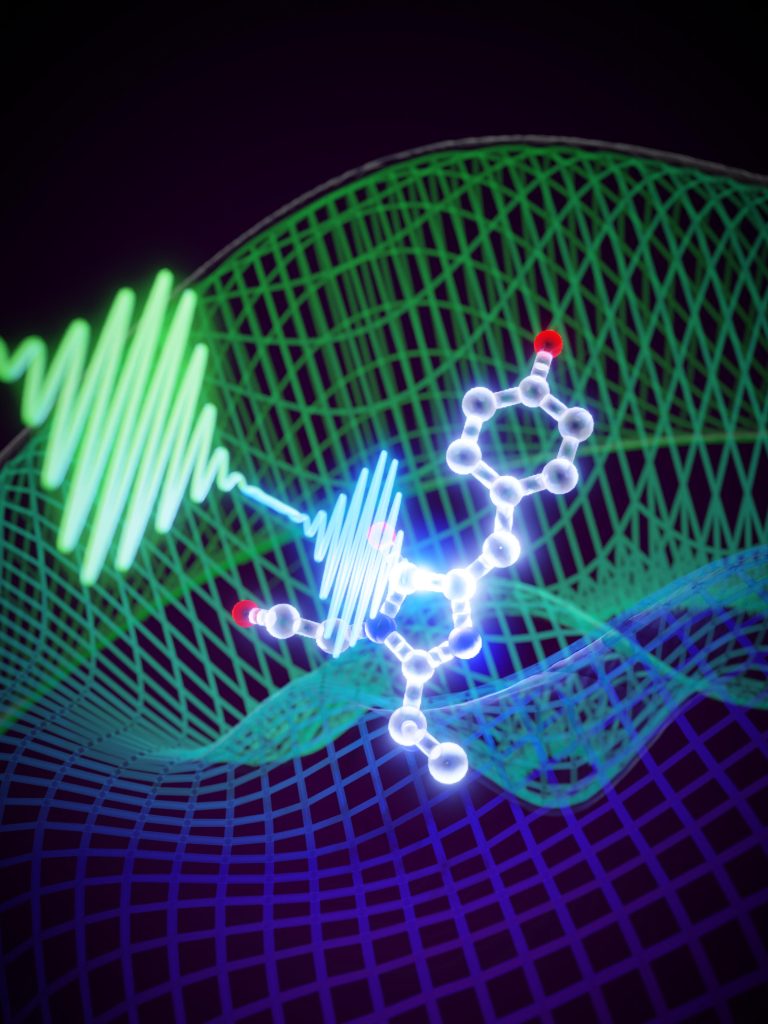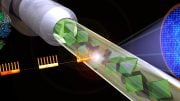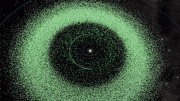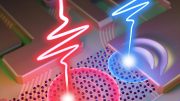
Combining two techniques, researchers have unveiled the crucial role of ‘coherence’ in molecular reactions, paving the way for advanced control of molecular dynamics. An illustration of the probing process. Credit: Samuel Perrett
Using ultrafast physics in structural biology has unveiled the intricate dance of molecular ‘coherence’ in unprecedented clarity.
Understanding how molecules transform in response to stimuli like light is fundamental in biology, for example during photosynthesis. Scientists have been working to unravel the workings of these changes in several fields, and by combining two of these, researchers have paved the way for a new era in understanding the reactions of protein molecules fundamental for life.
The large international research team, led by Professor Jasper van Thor from the Department of Life Sciences at Imperial, recently reported their findings in the journal Nature Chemistry.
Crystallography is a powerful technique in structural biology for taking ‘snapshots’ of how molecules are arranged. Over several large-scale experiments and years of theory work, the team behind the new study integrated this with another technique that maps vibrations in the electronic and nuclear configuration of molecules, called spectroscopy.
Demonstrating the new technique at powerful X-ray laser facilities around the world, the team showed that when molecules within the protein that they studied are optically excited, their very first movements are the result of ‘coherence’. This shows a vibrational effect, rather than motion for the functional part of the biological reaction that follows.
This important distinction, shown experimentally for the first time, highlights how the physics of spectroscopy can bring new insights to the classical crystallography methods of structural biology.
Professor van Thor said: “Every process that sustains life is carried out by proteins, but understanding how these complex molecules do their jobs depends on learning the arrangement of their atoms – and how this structure changes – as they react.
“Using methods from spectroscopy, we can now see ultrafast molecular movements that belong to the so-called coherence process directly in pictorial form by solving their crystal structures. We now have the tools to understand, and even control, molecular dynamics on extremely fast timescales at near-atomic resolution.
“We hope by sharing the methodological details of this new technique we can encourage researchers in both the fields of time-resolved structural biology as well as ultrafast laser spectroscopy to explore the crystallographic structures of coherences.”
Combining techniques
Combining the techniques required the use of X-ray free-electron laser (XFEL) facilities, including the Linac Coherent Light Source (LCLS) in the USA, the SPring-8 Angstrom Compact free electron LAser (SACLA) in Japan, the PAL-XFEL in Korea and recently also the European XFEL in Hamburg.
Members of the team have been working since 2009 at XFELs to use and understand the motions of reacting proteins on the femtosecond (one-millionth of one billionth of a second) timescale, known as femtochemistry. Following excitation by a laser pulse, ‘snapshots’ of the structure are taken using X-rays.
Early success with this technique in 2016 resulted in a detailed picture of the light-induced change in a biological protein. However, researchers still needed to address a key question: what is the origin of the tiny molecular ‘motions’ on the femtosecond time scale directly after the first laser light pulse?
Previous studies had assumed that all the motions correspond to the biological reaction, meaning its functional motion. But using the new method, the team found that this wasn’t the case in their experiments.
Coherent control
To reach this conclusion they created ‘coherent control’ – shaping the laser light to control the protein’s motions in a predictable manner. Following initial success in 2018 at LCLS in Stanford, checking and verifying the method required a total of six experiments at XFEL facilities around the world, each time assembling large teams and forming international collaborations
They then combined the data from these experiments with theoretical methods modified from femtochemistry, in order to apply them to X-ray crystallographic data rather than to spectroscopic data.
The conclusion was that the ultrafast motions measured with exquisite accuracy on the picometer scale and femtosecond time scale do not belong to the biological reaction, but instead to vibrational coherence in the remaining ground state.
This means that the molecules that are ‘left behind’ after the femtosecond laser pulse has passed dominate the motions that are subsequently measured, but only within the so-called vibrational coherence time.
Professor van Thor said: “We concluded that for our experiment, also if coherent control was not included, the conventional time-resolved measurement was in fact dominated by motions from the dark ‘reactant’ ground state, which are unrelated to the biological reactions that are triggered by the light. Instead, the motions correspond to what is traditionally measured by vibrational spectroscopy and have a very different, but equally important, significance
“This was actually predicted based on theoretical work made previously but has now been shown experimentally. This will have a significant impact in both the fields of time-resolved structural biology as well as ultrafast spectroscopy, as we have developed and provided the tools for analysis of ultrafast femtosecond time scale motion.”
Unprecedented collaboration
The paper includes 49 authors from 15 institutions, covering work over seven years, including experiments conducted remotely during the pandemic. It’s this sense of collaboration that made the result possible, according to Professor van Thor.
He said: “In a fast-moving field, where XFEL beamtime applications are incredibly competitive and there is pressure to publish from each individual experiment, I am extremely grateful to all the co-authors, team members, and collaborators for their perseverance, hard work, and investment in pursuing the greater objective, which required the strategic and much longer route that we have taken.”
Co-author Dr Sébastien Boutet, from the SLAC National Accelerator Laboratory, which hosts the LCLS, said: “These results represent what is truly unique about the capabilities of x-ray lasers. It demonstrates the type of knowledge on biology in motion that can only be achieved with very short bursts of x-rays and combined with cutting-edge laser technology. We see an exciting future of discovery in this area.”
Co-author Professor Gerrit Groenhof, from the University of Jyväskylä, Finland, said: “Using coherent control to extract the relevant molecular dynamics in the electronic excited state from other motions induced by the excitation laser is essential to understand how photoreceptor proteins have evolved to mediate the photo-activation process. Seeing such a molecular movie of photobiology in action is not only fascinating but may also be the key to unlocking biological principles for designing new light-responsive materials.”
Reference: “Optical control of ultrafast structural dynamics in a fluorescent protein” by Christopher D. M. Hutchison, James M. Baxter, Ann Fitzpatrick, Gabriel Dorlhiac, Alisia Fadini, Samuel Perrett, Karim Maghlaoui, Salomé Bodet Lefèvre, Violeta Cordon-Preciado, Josie L. Ferreira, Volha U. Chukhutsina, Douglas Garratt, Jonathan Barnard, Gediminas Galinis, Flo Glencross, Rhodri M. Morgan, Sian Stockton, Ben Taylor, Letong Yuan, Matthew G. Romei, Chi-Yun Lin, Jon P. Marangos, Marius Schmidt, Viktoria Chatrchyan, Tiago Buckup, Dmitry Morozov, Jaehyun Park, Sehan Park, Intae Eom, Minseok Kim, Dogeun Jang, Hyeongi Choi, HyoJung Hyun, Gisu Park, Eriko Nango, Rie Tanaka, Shigeki Owada, Kensuke Tono, Daniel P. DePonte, Sergio Carbajo, Matt Seaberg, Andrew Aquila, Sebastien Boutet, Anton Barty, So Iwata, Steven G. Boxer, Gerrit Groenhof and Jasper J. van Thor, 10 August 2023, Nature Chemistry.
DOI: 10.1038/s41557-023-01275-1









This information of molecular coherence should be added to the New Assembly Theory.there may be another experiment on physics .org with similar outcome with a hydrogen atom from a ammonia that was seen as a reaction coherence accomplished threw two detection methods simultaneously.